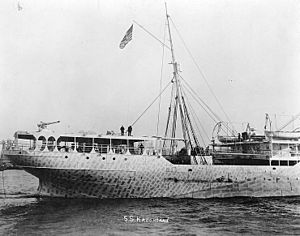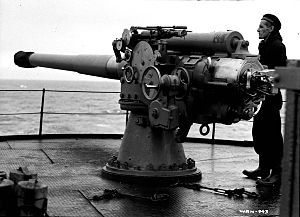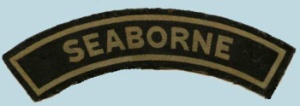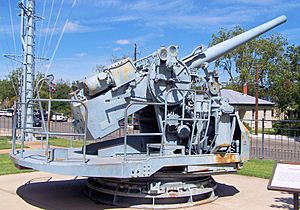Defensively equipped merchant ship facts for kids
Defensively equipped merchant ship (DEMS) was a special program started in June 1939 by the British Admiralty. Its goal was to add weapons to 5,500 British merchant ships. This helped them defend against enemy submarines and airplanes. The short name DEMS was used for the ships, the guns on them, the military people who used the guns, and the training places that supported the system.
Contents
Why Merchant Ships Needed Guns
For hundreds of years, countries like Spain, France, the Netherlands, and Britain put guns on their merchant ships. This was to stop pirates, enemy ships, and privateers from capturing them during trade. Ships carrying valuable goods from far away, like the East Indiamen, were built with strong defenses. Some were as powerful as naval warships. After 1815, faster, unarmed ships like clippers became popular. They were supposed to be fast enough to escape threats.
Growing Tensions Before World War I
In the early 1900s, tensions grew between powerful European countries. This included a naval arms race between Britain and Germany. It made people worry about the safety of merchant ships. In 1911, Winston Churchill, who was in charge of the British Navy, suggested arming British merchant ships for defense.
The British Navy formed a committee to study this idea. In 1912, Admiral Sir Francis Bridgeman warned that Germany was arming its merchant ships. He thought they might be used to attack British trade. Germany was arming fast passenger liners that could act as auxiliary cruisers (warships in disguise).
The British Navy decided to do the same. They started with the passenger ship RMS Aragon. It was supposed to carry naval guns in December 1912. However, there was a worry about how other countries would react. Even though arming merchant ships wasn't illegal, Britain feared foreign ports might not let armed British ships enter.
In January 1913, it was suggested to send a merchant ship with guns but no ammunition to see what would happen. This plan was approved. In March, the policy was made public. On April 25, 1913, Aragon left Southampton with two large guns on its back. Governments and people in South America didn't seem to mind.
Some people in Britain criticized the plan. They worried it would start another arms race at sea. Churchill said there was a difference between ships armed for war and those armed only for self-defense. The policy continued, and more ships like Aragon were armed. One of them, RMS Alcantara, later became an armed merchant cruiser in World War I.
World War I: Arming Merchant Ships
During the First World War, Britain blocked Germany's trade. Britain also armed its merchant ships to protect them from U-boats (German submarines). A single gun was placed at the back of the ship, similar to what a submarine might carry. Civilian captains were told to try and escape and shoot back from their more stable ship. By December 1915, 766 civilian ships had guns.
Arming merchant ships made Germany change its submarine tactics. Instead of following old rules for stopping ships, they started unrestricted submarine warfare. This meant they would sink ships without warning. This was a big reason why the United States joined the war against Germany.
The first merchant ship sunk by a U-boat was the British steamer Glitra on October 20, 1914. The German submarine U-17 stopped it and let the crew get into lifeboats before sinking the ship. This followed old rules for naval ships.
Germany declared the entire North Sea a war zone in November 1914. In February 1915, Germany declared all waters around the United Kingdom of Great Britain and Ireland a war zone. From February 18, 1915, they began sinking merchant ships in this zone without warning.
Even so, U-boats sometimes still tried to stop ships. But a typical submarine usually had only one gun. Merchant ships with guns could escape torpedo attacks more often. About one submarine per month was sunk while trying to stop a ship on the surface.
By September 1916, 1,749 civilian merchant ships had anti-submarine guns. By February 1917, this number grew to 2,899. The United States ended its diplomatic ties with Germany in February 1917. In March, the U.S. started arming its own merchant ships.
World War II: More Guns for Ships
After World War I, old naval guns were stored in ports. In the Second World War, the plan was to put a low-angle gun at the back of each ship to defend against submarines on the surface. They also added a high-angle gun and machine guns to protect against air attacks. By the end of 1940, 3,400 ships had guns. By 1943, all ships were armed.
The low-angle guns were usually 3 to 6 inches (75–150 mm) in size, depending on the ship. Small machine guns were later replaced by Oerlikon 20 mm cannon when they became available. The QF 12pdr Mk V mount was the most common anti-aircraft gun. Later, some ships received Bofors 40 mm guns.
About 24,000 Royal Navy personnel and 14,000 men from the Royal Artillery Maritime Regiment operated these DEMS guns. Also, 150,000 merchant sailors were trained to help by moving ammunition and loading guns. DEMS gunners were often retired military people or young new recruits. Large ships sometimes had a junior naval officer in charge of the gunners. Canada armed 713 ships, and the Royal Australian Navy provided gun crews for 375 Australian and Allied ships.
D-Day Landings and Aircraft Spotters
In 1944, during preparations for the D-Day landings in France, there was a big worry about Allied aircraft being shot down by friendly DEMS ships. Many DEMS ships would be involved. The Royal Observer Corps (ROC), which had experts in aircraft recognition, asked for volunteers. From 1,094 qualified people, 796 were chosen to help identify aircraft.
These "Seaborne Observers" were trained and temporarily joined the Royal Navy. They wore their ROC uniforms but had special "seaborne" shoulder patches and a Royal Navy armband. During the D-Day landings, two seaborne observers were placed on each British and American merchant ship. These ROC volunteers were given direct control of the ship's anti-aircraft guns. This greatly reduced "friendly fire" incidents, where friendly aircraft were accidentally shot.
Their success was clear. An air officer reported that most of the accidental firing came from warships, not merchant ships. He said he hadn't heard of a single pilot reporting a merchant ship firing on them. Twenty-two seaborne observers survived their ships being sunk, and two lost their lives. The "seaborne" operation was a huge success. As a result, King George VI allowed them to wear the "seaborne" patch permanently. Ten "seaborne" members also received special recognition for their bravery.
After the invasion, Air Chief Marshal Trafford Leigh-Mallory praised the ROC volunteers. He said they had saved many Allied aircraft and helped protect the ships at sea. He wanted their work to be widely known.
Japan's Armed Ships
The Imperial Japanese Army also created several shipping artillery units during World War II. These units sent small groups of soldiers to protect Army transport ships and rented merchant ships from air or submarine attacks. The Imperial Japanese Navy also formed air defense teams from April 1944 that were put on board ships.
United States Armed Ships
In the United States, a law from 1936 said that sailors on U.S. merchant ships were considered military personnel during wartime. However, Neutrality Acts stopped U.S. merchant ships from being armed until November 17, 1941. Still, American-owned ships registered in Panama were armed earlier. The guns were operated by the United States Navy Armed Guard.
The U.S. started putting guns and Navy Armed Guard on ships of other nations on January 24, 1942. About 145,000 U.S. Navy armed guards eventually sailed on 6,236 merchant ships. The U.S. policy was to arm ships sailing alone. Ships in convoys (groups of ships traveling together) could sometimes sail unarmed if their cargo was urgently needed.
The United States followed the British idea of having a single large gun at the back. Early U.S. ships used older 4-inch guns taken from old destroyers. In September 1942, new ships over 10,000 tons started getting dual-purpose 5-inch guns. Victory ships had a 3-inch gun at the front, several 20 mm machine guns along the sides and on the bridge, and a 5-inch gun at the stern (back).
Images for kids






